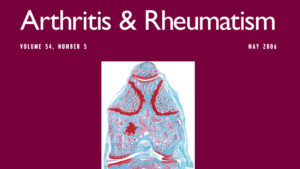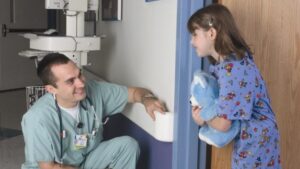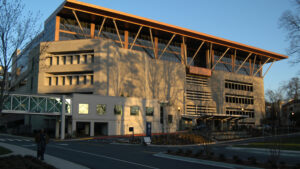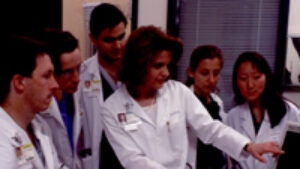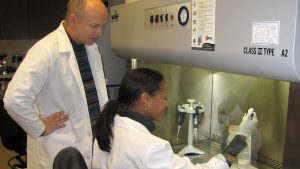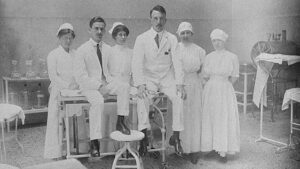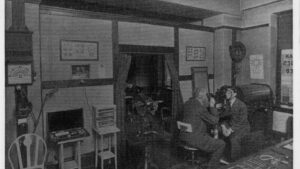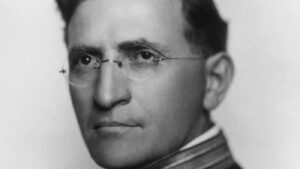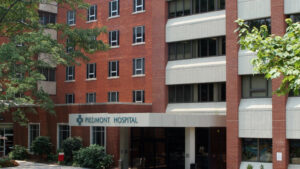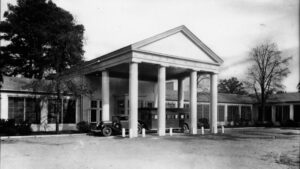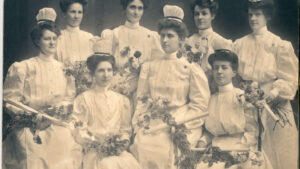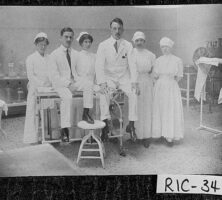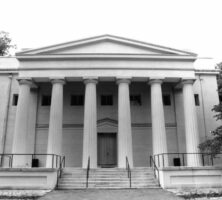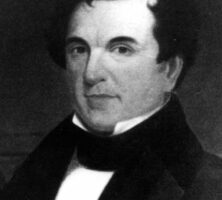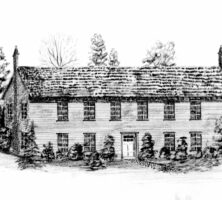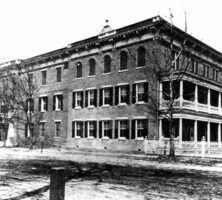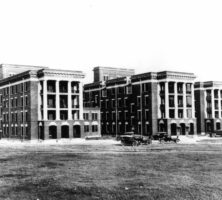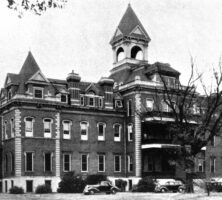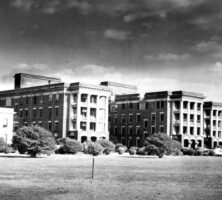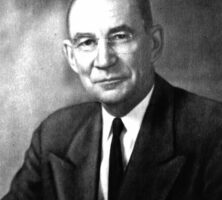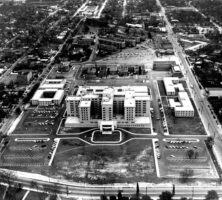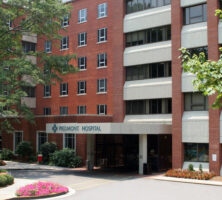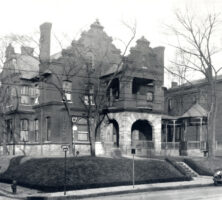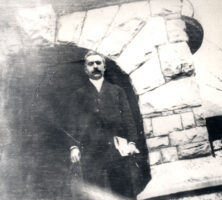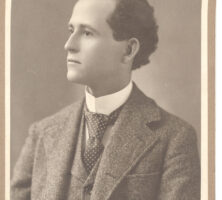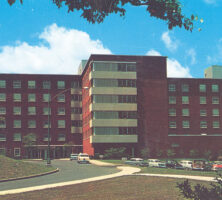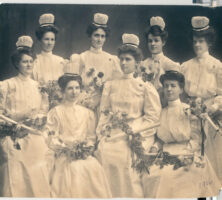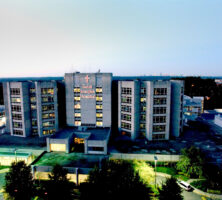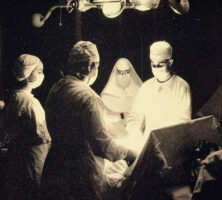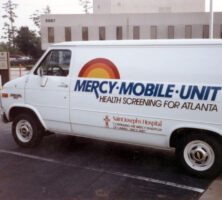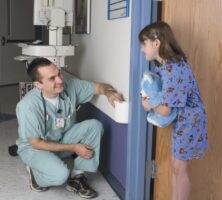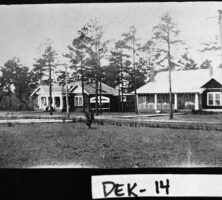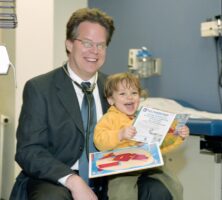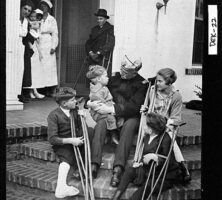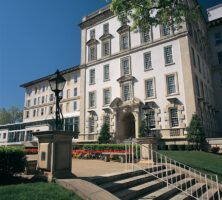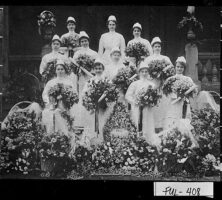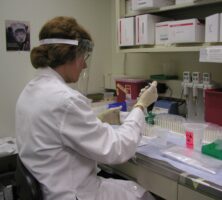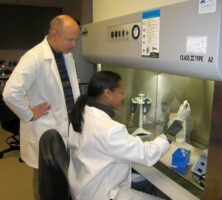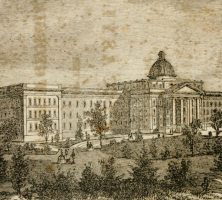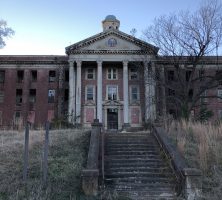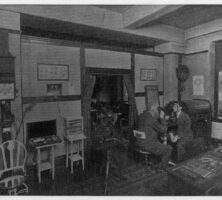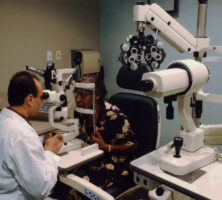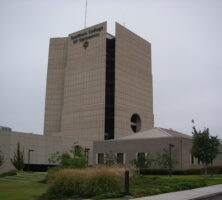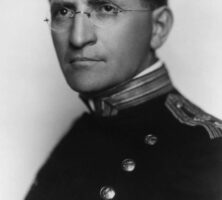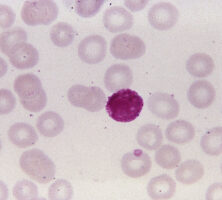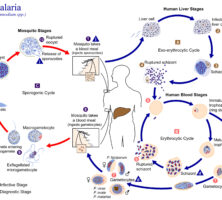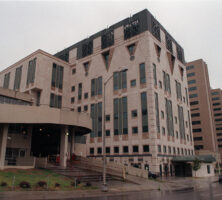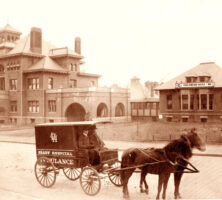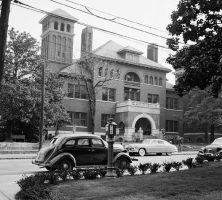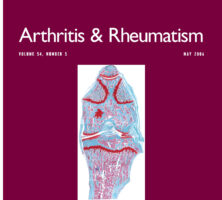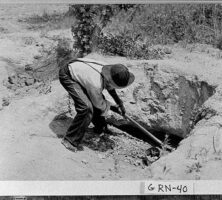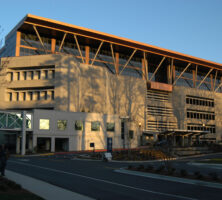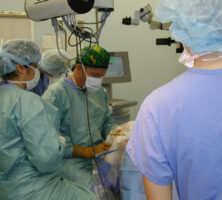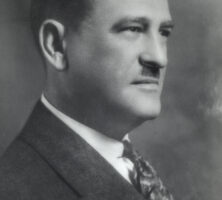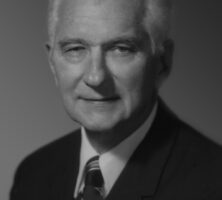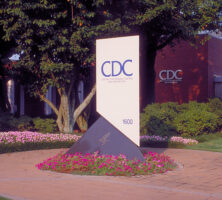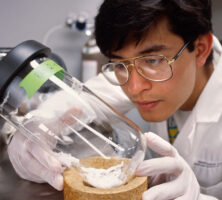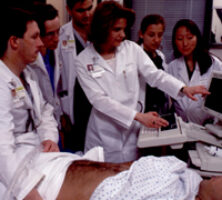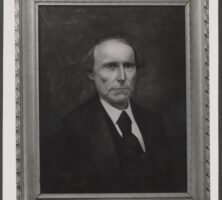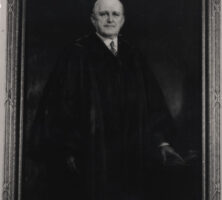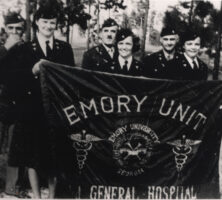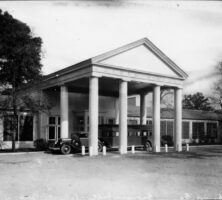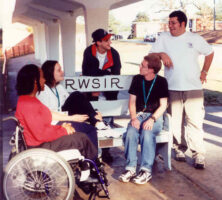The New Georgia Encyclopedia is supported by funding from A More Perfect Union, a special initiative of the National Endowment for the Humanities.
Members of the operating room staff at the Medical Department of UGA (later Georgia Health Sciences University) in Augusta are pictured in the early 1900s.
Courtesy of Georgia Archives, Vanishing Georgia, #
ric034.
The New Georgia Encyclopedia does not hold the copyright for this media resource and can neither grant nor deny permission to republish or reproduce the image online or in print. Requests for permission to publish or reproduce the resource should be submitted to the Georgia Archives.
The original building on the campus of Georgia Health Sciences University, completed in Augusta in 1837, was designed by the architect Charles B. Cluskey. The structure, Cluskey's first major building, is an excellent example of the Greek revival style.
Courtesy of Georgia Health Sciences University
The New Georgia Encyclopedia does not hold the copyright for this media resource and can neither grant nor deny permission to republish or reproduce the image online or in print. All requests for permission to publish or reproduce the resource must be submitted to the rights holder.
The New Georgia Encyclopedia does not hold the copyright for this media resource and can neither grant nor deny permission to republish or reproduce the image online or in print. All requests for permission to publish or reproduce the resource must be submitted to the rights holder.
Milton M. Antony, a physician in Augusta, was instrumental in the 1828 founding of the Medical Academy of Georgia, which later became Georgia Health Sciences University.
Courtesy of Historical Collections and Archives, Robert B. Greenblatt, M.D. Library, Georgia Health Sciences University
The New Georgia Encyclopedia does not hold the copyright for this media resource and can neither grant nor deny permission to republish or reproduce the image online or in print. All requests for permission to publish or reproduce the resource must be submitted to the rights holder.
The city hospital in Augusta, built in 1818, served as the first home for Georgia Health Sciences University, from 1828 until the mid-1830s.
Courtesy of Historical Collections and Archives, Robert B. Greenblatt, M.D. Library, Georgia Health Sciences University
The New Georgia Encyclopedia does not hold the copyright for this media resource and can neither grant nor deny permission to republish or reproduce the image online or in print. All requests for permission to publish or reproduce the resource must be submitted to the rights holder.
The New Georgia Encyclopedia does not hold the copyright for this media resource and can neither grant nor deny permission to republish or reproduce the image online or in print. All requests for permission to publish or reproduce the resource must be submitted to the rights holder.
A new city hospital in Augusta, which opened in 1869 and served for many years as the clinical training site for students at the Medical Department of UGA (later Georgia Health Sciences University), is pictured in 1894, following a renovation.
Courtesy of Historical Collections and Archives, Robert B. Greenblatt, M.D. Library, Georgia Health Sciences University
The New Georgia Encyclopedia does not hold the copyright for this media resource and can neither grant nor deny permission to republish or reproduce the image online or in print. All requests for permission to publish or reproduce the resource must be submitted to the rights holder.
University Hospital, completed in Augusta in 1915, was built for the Medical Department of UGA (later Georgia Health Sciences University) with the city's backing.
Courtesy of Historical Collections and Archives, Robert B. Greenblatt, M.D. Library, Georgia Health Sciences University
The New Georgia Encyclopedia does not hold the copyright for this media resource and can neither grant nor deny permission to republish or reproduce the image online or in print. All requests for permission to publish or reproduce the resource must be submitted to the rights holder.
The Newton Building, on the campus of the Medical College of Georgia (later Georgia Health Sciences University) in Augusta, was occupied by the college from 1913 until 1956. The structure was demolished in 1960.
Courtesy of Historical Collections and Archives, Robert B. Greenblatt, M.D. Library, Georgia Health Sciences University
The New Georgia Encyclopedia does not hold the copyright for this media resource and can neither grant nor deny permission to republish or reproduce the image online or in print. All requests for permission to publish or reproduce the resource must be submitted to the rights holder.
University Hospital, part of Georgia Health Sciences University in Augusta, was expanded in the mid-1930s as part of an effort to restore the good rating of the college and its membership in the Association of American Medical Colleges.
Courtesy of Historical Collections and Archives, Robert B. Greenblatt, M.D. Library, Georgia Health Sciences University
The New Georgia Encyclopedia does not hold the copyright for this media resource and can neither grant nor deny permission to republish or reproduce the image online or in print. All requests for permission to publish or reproduce the resource must be submitted to the rights holder.
G. Lombard Kelly served as dean of the Medical College of Georgia (later Georgia Health Sciences University) from 1934 until 1950, and as the college's first president from 1950 to 1953.
Courtesy of Historical Collections and Archives, Robert B. Greenblatt, M.D. Library, Georgia Health Sciences University
The New Georgia Encyclopedia does not hold the copyright for this media resource and can neither grant nor deny permission to republish or reproduce the image online or in print. All requests for permission to publish or reproduce the resource must be submitted to the rights holder.
The Eugene Talmadge Memorial Hospital in Augusta, built by the state for the Medical College of Georgia (later Georgia Health Sciences University), opened in June 1956 with six buildings.
Courtesy of Historical Collections and Archives, Robert B. Greenblatt, M.D. Library, Georgia Health Sciences University
The New Georgia Encyclopedia does not hold the copyright for this media resource and can neither grant nor deny permission to republish or reproduce the image online or in print. All requests for permission to publish or reproduce the resource must be submitted to the rights holder.
Piedmont Hospital, located in the Buckhead community of Atlanta, is a private, not-for-profit institution founded in 1905. An acute tertiary-care facility, Piedmont Hospital is the flagship institution of Piedmont Healthcare.
Courtesy of Piedmont Hospital Archives
The New Georgia Encyclopedia does not hold the copyright for this media resource and can neither grant nor deny permission to republish or reproduce the image online or in print. All requests for permission to publish or reproduce the resource must be submitted to the rights holder.
The first facility for Piedmont Hospital, pictured circa 1915, was a fifteen-room home located at the corner of Capitol Avenue and Crumley Street in downtown Atlanta. The hospital, founded in 1905 as Piedmont Sanatorium, remained in this location until 1957.
Courtesy of Piedmont Hospital Archives
The New Georgia Encyclopedia does not hold the copyright for this media resource and can neither grant nor deny permission to republish or reproduce the image online or in print. All requests for permission to publish or reproduce the resource must be submitted to the rights holder.
Dr. Ludwig Amster, a specialist in gastrointestinal diseases, stands outside the Piedmont Sanatorium circa 1920. Amster founded the facility, known today as Piedmont Hospital, in 1905 with surgeon Dr. Floyd W. McRae Sr.
Courtesy of Piedmont Hospital Archives
The New Georgia Encyclopedia does not hold the copyright for this media resource and can neither grant nor deny permission to republish or reproduce the image online or in print. All requests for permission to publish or reproduce the resource must be submitted to the rights holder.
Dr. Floyd W. McRae Sr., pictured in 1895, was a surgeon and the cofounder of Piedmont Sanatorium (later Piedmont Hospital), which opened in 1905 in downtown Atlanta.
Photograph from C. W. Motes, in Piedmont Hospital Archives
The New Georgia Encyclopedia does not hold the copyright for this media resource and can neither grant nor deny permission to republish or reproduce the image online or in print. All requests for permission to publish or reproduce the resource must be submitted to the rights holder.
In 1957 Piedmont Hosptial, pictured circa 1960, moved from downtown Atlanta to the Buckhead community of Atlanta. At that time the facility had 250 beds and a staff of 127 physicians.
Courtesy of Piedmont Hospital Archives
The New Georgia Encyclopedia does not hold the copyright for this media resource and can neither grant nor deny permission to republish or reproduce the image online or in print. All requests for permission to publish or reproduce the resource must be submitted to the rights holder.
Graduates of Saint Joseph's Nursing School in Atlanta pose in 1906. The nursing school opened in 1900 and operated until 1973, graduating a total of more than 1,300 nurses.
Courtesy of Saint Joseph's Hospital
The New Georgia Encyclopedia does not hold the copyright for this media resource and can neither grant nor deny permission to republish or reproduce the image online or in print. All requests for permission to publish or reproduce the resource must be submitted to the rights holder.
Saint Joseph's Hospital, located on a thirty-two-acre campus in north Atlanta since 1973, is the oldest medical facility in Atlanta. Founded by Catholic nuns in 1880, Saint Joseph's is nationally recognized for excellence in both patient care and research.
Courtesy of Saint Joseph's Hospital
The New Georgia Encyclopedia does not hold the copyright for this media resource and can neither grant nor deny permission to republish or reproduce the image online or in print. All requests for permission to publish or reproduce the resource must be submitted to the rights holder.
Saint Joseph's Hospital in Atlanta has been a forerunner in the Southeast for developing surgical procedures, from performing the region's first open-heart surgery in 1957 to utilizing minimally invasive robotic surgery in the twenty-first century.
Courtesy of Saint Joseph's Hospital
The New Georgia Encyclopedia does not hold the copyright for this media resource and can neither grant nor deny permission to republish or reproduce the image online or in print. All requests for permission to publish or reproduce the resource must be submitted to the rights holder.
Saint Joseph's Hospital, originally known as Atlanta Hospital, first opened in a home on Baker Street in Atlanta. The facility later moved to a building on Courtland Street before dedicating its current location in north Atlanta in 1973.
Courtesy of Saint Joseph's Hospital
The New Georgia Encyclopedia does not hold the copyright for this media resource and can neither grant nor deny permission to republish or reproduce the image online or in print. All requests for permission to publish or reproduce the resource must be submitted to the rights holder.
As part of its original mission to offer medical care to the poor, Saint Joseph's Hospital in Atlanta operates the Mercy Care Services program, which includes two health clinics and eight mobile satellite locations as of 2007.
Courtesy of Saint Joseph's Hospital
The New Georgia Encyclopedia does not hold the copyright for this media resource and can neither grant nor deny permission to republish or reproduce the image online or in print. All requests for permission to publish or reproduce the resource must be submitted to the rights holder.
Children's Healthcare of Atlanta was formed in 1998 by the merger of Egleston Children's Health Care System and the Scottish Rite Children's Medical Center. A not-for-profit pediatric hospital, Children's served approximately 493,000 patients in 2005.
Courtesy of Children's Healthcare of Atlanta
The New Georgia Encyclopedia does not hold the copyright for this media resource and can neither grant nor deny permission to republish or reproduce the image online or in print. All requests for permission to publish or reproduce the resource must be submitted to the rights holder.
The Scottish Rite Convalescent Home for Crippled Children, pictured circa 1916, consisted of two wood-frame cottages. The facility opened in Decatur in 1915 and provided post-surgical care to indigent children.
Courtesy of Georgia Archives, Vanishing Georgia, #
dek014.
The New Georgia Encyclopedia does not hold the copyright for this media resource and can neither grant nor deny permission to republish or reproduce the image online or in print. Requests for permission to publish or reproduce the resource should be submitted to the Georgia Archives.
In 2003 Dante Priebe (right) underwent a successful liver-transplant operation, performed by Dr. Thomas Heffron (left) at Children's Healthcare of Atlanta.
Courtesy of Children's Healthcare of Atlanta
The New Georgia Encyclopedia does not hold the copyright for this media resource and can neither grant nor deny permission to republish or reproduce the image online or in print. All requests for permission to publish or reproduce the resource must be submitted to the rights holder.
Patients at the Scottish Rite Hospital for Crippled Children in Decatur are pictured circa 1920. Founded in 1915, the Scottish Rite Hospital merged with the Henrietta Egleston Hospital for Children in 1998 to form Children's Healthcare of Atlanta.
Courtesy of Georgia Archives, Vanishing Georgia, #
dek022.
The New Georgia Encyclopedia does not hold the copyright for this media resource and can neither grant nor deny permission to republish or reproduce the image online or in print. Requests for permission to publish or reproduce the resource should be submitted to the Georgia Archives.
Emory University Hospital, located on the campus of Emory University in Atlanta, is a tertiary care facility. Staffed by 1500 physicians, the facility has been the site of several important milestones in the medical history of Georgia, including the performance of the state's first heart, kidney, and lung transplants.
Courtesy of Emory University Hospital
The New Georgia Encyclopedia does not hold the copyright for this media resource and can neither grant nor deny permission to republish or reproduce the image online or in print. All requests for permission to publish or reproduce the resource must be submitted to the rights holder.
A class of graduating nurses poses outside Wesley Memorial Hospital in Atlanta, later Emory University Hospital, in 1916. Wesley Memorial, chartered in 1904, was located in a mansion on Courtland Street until 1922, when the hospital moved to the Emory University campus in DeKalb County.
Courtesy of Georgia Archives, Vanishing Georgia, #
ful0408.
The New Georgia Encyclopedia does not hold the copyright for this media resource and can neither grant nor deny permission to republish or reproduce the image online or in print. Requests for permission to publish or reproduce the resource should be submitted to the Georgia Archives.
Students in the Out of School Girls Project, instituted by CARE in 2003, attend school in Afghanistan. CARE, an Atlanta-based humanitarian organization, focuses on the education of women as one means toward fulfilling its mission of eradicating global poverty.
Courtesy of CARE, Photograph by Phil Borges.
The New Georgia Encyclopedia does not hold the copyright for this media resource and can neither grant nor deny permission to republish or reproduce the image online or in print. All requests for permission to publish or reproduce the resource must be submitted to the rights holder.
Clara Chinyama, with her daughter Alinafe, poses at the construction site of her new tea shop in Malawi. The shop is funded through a savings and loan program provided by CARE, an Atlanta-based organization that works with women around the world to overcome poverty, disease, and environmental problems.
Courtesy of CARE, Photograph by Valenda Campbell.
The New Georgia Encyclopedia does not hold the copyright for this media resource and can neither grant nor deny permission to republish or reproduce the image online or in print. All requests for permission to publish or reproduce the resource must be submitted to the rights holder.
Rhesus macaques are among the seven species of nonhuman primates studied at the Yerkes National Primate Research Center, based in Atlanta at Emory University. These macaques are pictured at the center's field station in Lawrenceville.
Courtesy of Yerkes National Primate Research Center
The New Georgia Encyclopedia does not hold the copyright for this media resource and can neither grant nor deny permission to republish or reproduce the image online or in print. All requests for permission to publish or reproduce the resource must be submitted to the rights holder.
The main center of the Yerkes National Primate Research Center comprises the Neuroscience Building (left), the original building (center), and the Emory Vaccine Center (right). Emory University assumed ownership of the center in 1956.
Courtesy of Yerkes National Primate Research Center
The New Georgia Encyclopedia does not hold the copyright for this media resource and can neither grant nor deny permission to republish or reproduce the image online or in print. All requests for permission to publish or reproduce the resource must be submitted to the rights holder.
Robert Mearns Yerkes, pictured in Orange Park, Florida, founded the Yale Laboratories of Primate Biology in New Haven, Connecticut, in 1928. A year later the facility moved to Orange Park, where it remained until Yerkes's death in 1956. The center was renamed in his honor and relocated to Emory University in Atlanta that same year.
Courtesy of Yerkes National Primate Research Center
The New Georgia Encyclopedia does not hold the copyright for this media resource and can neither grant nor deny permission to republish or reproduce the image online or in print. All requests for permission to publish or reproduce the resource must be submitted to the rights holder.
A researcher at the Yerkes National Primate Research Center, based at Emory University in Atlanta, works in the Biomarkers Core laboratory. The biomedical research conducted at the center helps to provide treatment and prevention strategies for human illnesses.
Courtesy of Yerkes National Primate Research Center
The New Georgia Encyclopedia does not hold the copyright for this media resource and can neither grant nor deny permission to republish or reproduce the image online or in print. All requests for permission to publish or reproduce the resource must be submitted to the rights holder.
Arthritis Today, a bimonthly magazine produced by the Arthritis Foundation, provides information and support to arthritis patients around the country. Established in 1948 and based in Atlanta, the Arthritis Foundation is the largest voluntary health organization in the United States.
Photograph by Daniel Mayer
The New Georgia Encyclopedia does not hold the copyright for this media resource and can neither grant nor deny permission to republish or reproduce the image online or in print. All requests for permission to publish or reproduce the resource must be submitted to the rights holder.
Jin-Xiong She, the director of the Center for Biotechnology and Genomic Medicine at the Medical College of Georgia (later Georgia Health Sciences University) in Augusta, observes a researcher at work, circa 2006. The center engages in interdisciplinary research to develop treatments for such diseases as diabetes and cancer.
Photograph by Phil Jones
The New Georgia Encyclopedia does not hold the copyright for this media resource and can neither grant nor deny permission to republish or reproduce the image online or in print. All requests for permission to publish or reproduce the resource must be submitted to the rights holder.
Mark Bouzyk, director of the Center for Medical Genomics at Emory University, watches a research assistant prepare samples for DNA extraction. Emory supports one of the nation's largest academic genetics departments.
Photograph by Janet Nichols
The New Georgia Encyclopedia does not hold the copyright for this media resource and can neither grant nor deny permission to republish or reproduce the image online or in print. All requests for permission to publish or reproduce the resource must be submitted to the rights holder.
Georgia Health Sciences University in Augusta supports the Center for Biotechnology and Genomic Medicine, which promotes genomics, proteomics, and bioinformatics research in an interdisciplinary setting.
Photograph by Phil Jones
The New Georgia Encyclopedia does not hold the copyright for this media resource and can neither grant nor deny permission to republish or reproduce the image online or in print. All requests for permission to publish or reproduce the resource must be submitted to the rights holder.
The Powell Building at Central State Hospital near Milledgeville was the original building of the Georgia Lunatic Asylum when it first opened in 1842. Named after Superintendent Theophilus O. Powell (1837–1907), the building's role changed multiple times over its long history, most recently serving as an administrative center for Central State Hospital.
Courtesy of Jonathan D. Hepworth, New Georgia Encyclopedia
The New Georgia Encyclopedia does not hold the copyright for this media resource and can neither grant nor deny permission to republish or reproduce the image online or in print. All requests for permission to publish or reproduce the resource must be submitted to the rights holder.
The main building of the Georgia Lunatic Asylum (now called the Powell Building of Central State Hospital) near Milledgeville first opened to receive patients in 1842. This engraving of the domed building is taken from an 1861 report by the asylum.
From Duke University
The New Georgia Encyclopedia does not hold the copyright for this media resource and can neither grant nor deny permission to republish or reproduce the image online or in print. All requests for permission to publish or reproduce the resource must be submitted to the rights holder.
By the time this bird's eye drawing was made for the 1913 Georgia State Sanitarium report, the institution had expanded substantially beyond the domed Powell Building (left center). A convalescent female ward (bottom right) was mirrored by a convalescent male ward (bottom left), while an overcrowded building for African Americans had been recently completed (top, center fold). The "twin buildings" (x-shaped, top left) housed white male patients and were connected by a kitchen and dining complex. The sanitarium's farm stretched out beyond.
From University of Georgia Libraries
The New Georgia Encyclopedia does not hold the copyright for this media resource and can neither grant nor deny permission to republish or reproduce the image online or in print. All requests for permission to publish or reproduce the resource must be submitted to the rights holder.
The Jones Building at Central State Hospital was completed in the late 1920s. It originally housed the Psychopathic Hospital of Milledgeville State Hospital. Largely abandoned a decade ago, its condition has deteriorated extensively as shown in this 2021 photo.
Courtesy of Jonathan D. Hepworth, New Georgia Encyclopedia
The New Georgia Encyclopedia does not hold the copyright for this media resource and can neither grant nor deny permission to republish or reproduce the image online or in print. All requests for permission to publish or reproduce the resource must be submitted to the rights holder.
Central State Hospital in Milledgeville, pictured in 2000, has provided mental health care in Georgia since 1837. Today the hospital's services include specialized care as well as secure facilities for the state's criminal justice system.
Courtesy of Central State Hospital
The New Georgia Encyclopedia does not hold the copyright for this media resource and can neither grant nor deny permission to republish or reproduce the image online or in print. All requests for permission to publish or reproduce the resource must be submitted to the rights holder.
This tinted postcard of the Georgia State Sanitarium (later Central State Hospital) depicts the grounds of the institution circa 1905. During this time the hospital was under the leadership of Theophilus O. Powell, who implemented more precise methods of diagnosis.
Courtesy of Melinda Smith Mullikin, New Georgia Encyclopedia
The New Georgia Encyclopedia does not hold the copyright for this media resource and can neither grant nor deny permission to republish or reproduce the image online or in print. All requests for permission to publish or reproduce the resource must be submitted to the rights holder.
The New Georgia Encyclopedia does not hold the copyright for this media resource and can neither grant nor deny permission to republish or reproduce the image online or in print. All requests for permission to publish or reproduce the resource must be submitted to the rights holder.
An optometrist examines a patient in 1915. The Georgia Optical Association (now the Georgia Optometric Association) was founded in 1904, and the first state regulatory laws for optometry were passed in 1916.
Courtesy of American Optometric Association
The New Georgia Encyclopedia does not hold the copyright for this media resource and can neither grant nor deny permission to republish or reproduce the image online or in print. All requests for permission to publish or reproduce the resource must be submitted to the rights holder.
A patient in 2004 undergoes an eye examination. Advances in technology over the last century have expanded the capabilities of optometrists to diagnose and treat various eye conditions. With around 860 licensed optometrists working in more than 150 counties in the state, Georgians have wide access to these services.
Courtesy of Southern College of Optometry
The New Georgia Encyclopedia does not hold the copyright for this media resource and can neither grant nor deny permission to republish or reproduce the image online or in print. All requests for permission to publish or reproduce the resource must be submitted to the rights holder.
Southern College of Optometry in Memphis, Tennessee, is one of four optometry schools in the Southeast. Because an optometry school does not exist in Georgia, the state covers out-of-state tuition costs for Georgia students who are accepted at Southern College.
Image from Halpaugh
The New Georgia Encyclopedia does not hold the copyright for this media resource and can neither grant nor deny permission to republish or reproduce the image online or in print. All requests for permission to publish or reproduce the resource must be submitted to the rights holder.
After observing mill towns, mental hospitals, and orphanages in the South, epidemiologist Joseph Goldberger determined that malnutrition was the cause of pellagra. Goldberger's work led other doctors to discover the exact cause of the disease, a niacin deficiency.
Courtesy of Centers for Disease Control and Prevention
The New Georgia Encyclopedia does not hold the copyright for this media resource and can neither grant nor deny permission to republish or reproduce the image online or in print. All requests for permission to publish or reproduce the resource must be submitted to the rights holder.
A Stearman biplane sprays an insecticide during malaria control operations in Savannah.
Courtesy of Centers for Disease Control and Prevention, Department of Health and Human Services
The New Georgia Encyclopedia does not hold the copyright for this media resource and can neither grant nor deny permission to republish or reproduce the image online or in print. All requests for permission to publish or reproduce the resource must be submitted to the rights holder.
This thin film micrograph depicts an immature cell of the protozoan species that produces malaria; it is magnified 1,125 times.
Courtesy of Centers for Disease Control and Prevention, Department of Health and Human Services
The New Georgia Encyclopedia does not hold the copyright for this media resource and can neither grant nor deny permission to republish or reproduce the image online or in print. All requests for permission to publish or reproduce the resource must be submitted to the rights holder.
Illustration of the life cycle of the parasites of the genus Plasmodium, which are the causal agents of malaria.
Courtesy of Centers for Disease Control and Prevention, Department of Health and Human Services
The New Georgia Encyclopedia does not hold the copyright for this media resource and can neither grant nor deny permission to republish or reproduce the image online or in print. All requests for permission to publish or reproduce the resource must be submitted to the rights holder.
A Malaria Control in War Areas building in Newtown, 1953. The MCWA was created during World War II to help control the spread of malaria, carried by mosquitoes, in the South, particularly in areas around military bases
Courtesy of Centers for Disease Control and Prevention, Department of Health and Human Services
The New Georgia Encyclopedia does not hold the copyright for this media resource and can neither grant nor deny permission to republish or reproduce the image online or in print. All requests for permission to publish or reproduce the resource must be submitted to the rights holder.
Electron micrographs of variola, varicella, and vaccinia virions, or infectious particles of the virus cells.
Courtesy of Centers for Disease Control and Prevention, Department of Health and Human Services
The New Georgia Encyclopedia does not hold the copyright for this media resource and can neither grant nor deny permission to republish or reproduce the image online or in print. All requests for permission to publish or reproduce the resource must be submitted to the rights holder.
The New Georgia Encyclopedia does not hold the copyright for this media resource and can neither grant nor deny permission to republish or reproduce the image online or in print. All requests for permission to publish or reproduce the resource must be submitted to the rights holder.
Grady Memorial Hospital, a major teaching hospital in Atlanta, provides care to more than 1 million outpatients annually. The building, designed in the modern style by Robert and Company, was completed in 1958. In the early 1990s, the hospital was renovated and expanded by Stanley, Love-Stanley.
Courtesy of Atlanta Journal-Constitution.
The New Georgia Encyclopedia does not hold the copyright for this media resource and can neither grant nor deny permission to republish or reproduce the image online or in print. All requests for permission to publish or reproduce the resource must be submitted to the Atlanta Journal-Constitution.
An ambulance waits in front of Grady Memorial Hospital in 1896. Named in honor of journalist Henry W. Grady, the hospital was built in downtown Atlanta in 1892.
The New Georgia Encyclopedia does not hold the copyright for this media resource and can neither grant nor deny permission to republish or reproduce the image online or in print. Requests for permission to publish or reproduce the resource should be submitted to Special Collections and Archives at Georgia State University.
African American children work on art projects at Grady Hospital in 1953. The hospital, segregated until the 1960s, was often referred to as "the Gradies" because of its separate facilities for Black patients and white patients.
Courtesy of Special Collections & Archives, Georgia State University Library, Lane Brothers Commercial Photographers Photographic Collection.
The New Georgia Encyclopedia does not hold the copyright for this media resource and can neither grant nor deny permission to republish or reproduce the image online or in print. Requests for permission to publish or reproduce the resource should be submitted to Special Collections and Archives at Georgia State University.
Grady Memorial Hospital has often been among the first to implement new medical technology. The hospital's most notable achievements include performing the state's first open-heart surgery in 1921, opening the world's first cancer center in 1923, and acquiring the earliest dialysis and X-ray machines. Grady Hospital's original building, shown here in 1952, was re-purposed when the hospital built new structures for white and Black patients in 1912.
Courtesy of Special Collections & Archives, Georgia State University Library, Lane Brothers Commercial Photographers Photographic Collection.
The New Georgia Encyclopedia does not hold the copyright for this media resource and can neither grant nor deny permission to republish or reproduce the image online or in print. Requests for permission to publish or reproduce the resource should be submitted to Special Collections and Archives at Georgia State University.
Arthritis and Rheumatism is one of two journals published by the American College of Rheumatology. The peer-reviewed monthly features articles on all aspects of rheumatic disease.
The New Georgia Encyclopedia does not hold the copyright for this media resource and can neither grant nor deny permission to republish or reproduce the image online or in print. All requests for permission to publish or reproduce the resource must be submitted to the rights holder.
Pictured in 1941, an African American man digs for white clay in Siloam, Greene County. Photograph by Jack Delano for the Farm Security Administration.
Courtesy of Georgia Archives, Vanishing Georgia, #
grn040.
The New Georgia Encyclopedia does not hold the copyright for this media resource and can neither grant nor deny permission to republish or reproduce the image online or in print. Requests for permission to publish or reproduce the resource should be submitted to the Georgia Archives.
The Emory Eye Center is currently in the top ten eye-research institutions in the country in the amount of funds granted by the National Institutes of Health.
Courtesy of Emory Eye Center
The New Georgia Encyclopedia does not hold the copyright for this media resource and can neither grant nor deny permission to republish or reproduce the image online or in print. All requests for permission to publish or reproduce the resource must be submitted to the rights holder.
Emory Eye Center continues to practice cutting-edge surgery and research on eyes, much as it has since its inception in 1872.
Courtesy of Emory Eye Center
The New Georgia Encyclopedia does not hold the copyright for this media resource and can neither grant nor deny permission to republish or reproduce the image online or in print. All requests for permission to publish or reproduce the resource must be submitted to the rights holder.
Grady Clay developed an academic program for ophthalmology students and for eye, ear, nose, and throat resident physicians. Clay served as department chair at Emory School of Medicine from 1940 until 1946.
Courtesy of Emory Eye Center
The New Georgia Encyclopedia does not hold the copyright for this media resource and can neither grant nor deny permission to republish or reproduce the image online or in print. All requests for permission to publish or reproduce the resource must be submitted to the rights holder.
F. Phinizy Calhoun Jr. served as chair of the Emory School of Medicine Ophthalmology Department from 1946 until 1978. During his tenure he helped open an eye bank, the fifth in the United States, to serve patients in the Southeast who needed cornea transplants. He is credited with bringing modern ophthalmology to Georgia.
Courtesy of Emory Eye Center
The New Georgia Encyclopedia does not hold the copyright for this media resource and can neither grant nor deny permission to republish or reproduce the image online or in print. All requests for permission to publish or reproduce the resource must be submitted to the rights holder.
The new free-standing facility for the John B. Amos Cancer Center of the Columbus Regional Healthcare System was dedicated in 2004. The center was established through an endowment provided by Aflac cofounder John Amos in 1990; he died of lung cancer that same year.
Courtesy of Aflac
The New Georgia Encyclopedia does not hold the copyright for this media resource and can neither grant nor deny permission to republish or reproduce the image online or in print. All requests for permission to publish or reproduce the resource must be submitted to the rights holder.
By 1992 the Center for Disease Control had expanded far beyond communicable diseases, and the agency's name was changed to the Centers for Disease Control and Prevention. (The acronym remained CDC by law.)
Courtesy of Centers for Disease Control and Prevention
The New Georgia Encyclopedia does not hold the copyright for this media resource and can neither grant nor deny permission to republish or reproduce the image online or in print. All requests for permission to publish or reproduce the resource must be submitted to the rights holder.
The Centers for Disease Control and Prevention headquarters are located on Clifton Road in Atlanta. CDC is the nation's premier public health agency and a unit of the U.S. Department of Health and Human Services.
Image from James Gathany, Centers for Disease Control and Prevention
The New Georgia Encyclopedia does not hold the copyright for this media resource and can neither grant nor deny permission to republish or reproduce the image online or in print. All requests for permission to publish or reproduce the resource must be submitted to the rights holder.
In 1947 Emory University donated fifteen acres of land on Clifton Road for the new CDC headquarters, but construction did not begin for more than a decade.
Courtesy of Centers for Disease Control and Prevention
The New Georgia Encyclopedia does not hold the copyright for this media resource and can neither grant nor deny permission to republish or reproduce the image online or in print. All requests for permission to publish or reproduce the resource must be submitted to the rights holder.
The Clifton Road headquarters for the Centers for Disease Control and Prevention in Atlanta was under construction in 1959.
Courtesy of Centers for Disease Control and Prevention
The New Georgia Encyclopedia does not hold the copyright for this media resource and can neither grant nor deny permission to republish or reproduce the image online or in print. All requests for permission to publish or reproduce the resource must be submitted to the rights holder.
A nurse delivering immunization injections to school children in 1948. The vaccines against Diptheria, Tetnus and Pertussis were combined in 1948 which became known as the DTP vaccine.
Courtesy of Nova Jane McCombs and Georgia Department of Human Resources, Division of Public Health
The New Georgia Encyclopedia does not hold the copyright for this media resource and can neither grant nor deny permission to republish or reproduce the image online or in print. All requests for permission to publish or reproduce the resource must be submitted to the rights holder.
The American Cancer Society's nationwide annual fund-raiser, Relay for Life, is held in various locations around Georgia. A voluntary health organization, the society is dedicated to eliminating cancer through research, education, advocacy, and service.
The New Georgia Encyclopedia does not hold the copyright for this media resource and can neither grant nor deny permission to republish or reproduce the image online or in print. All requests for permission to publish or reproduce the resource must be submitted to the rights holder.
Nearly all the latest discoveries in cancer research began with funding provided by the American Cancer Society. Between 1946 and 2003, the American Cancer Society distributed $2.5 billion to researchers.
The New Georgia Encyclopedia does not hold the copyright for this media resource and can neither grant nor deny permission to republish or reproduce the image online or in print. All requests for permission to publish or reproduce the resource must be submitted to the rights holder.
Emory University School of Medicine students gain medical experience with bedside teaching. Emory's medical school ranks among the nation's finest institutions for teaching, patient care, and research.
Courtesy of Emory University
The New Georgia Encyclopedia does not hold the copyright for this media resource and can neither grant nor deny permission to republish or reproduce the image online or in print. All requests for permission to publish or reproduce the resource must be submitted to the rights holder.
The first dean of Atlanta Medical College (later Emory School of Medicine), John Westmoreland pioneered research in yellow fever, cofounded the Atlanta Medical and Surgical Journal, and helped found Atlanta's first medical society, the Brotherhood of Physicians, responsible for establishing a local medical code of ethics.
The New Georgia Encyclopedia does not hold the copyright for this media resource and can neither grant nor deny permission to republish or reproduce the image online or in print. For more information about this resource, contact the Stuart A. Rose Manuscript, Archives, and Rare Book Library at Emory University.
William Simpson Elkin was dean of Emory's medical school from 1915 to 1925. Elkin oversaw the medical school's move to Emory's campus in Atlanta's Druid Hills neighborhood in 1917 and the addition of a new hospital facility in 1922.
The New Georgia Encyclopedia does not hold the copyright for this media resource and can neither grant nor deny permission to republish or reproduce the image online or in print. For more information about this resource, contact the Stuart A. Rose Manuscript, Archives, and Rare Book Library at Emory University.
Robert W. Woodruff became president of both the Trust Company of Georgia and the Coca-Cola Company in 1923 and eventually became the architect of Coke's worldwide expansion. In later years Woodruff was also Emory University's greatest benefactor. In 1937 he established the Robert W. Woodruff Foundation, a charitable organization.
Image from oaktree_b
The New Georgia Encyclopedia does not hold the copyright for this media resource and can neither grant nor deny permission to republish or reproduce the image online or in print. All requests for permission to publish or reproduce the resource must be submitted to the rights holder.
Emory organized medical units in both world wars to care for wounded soldiers behind front lines. Recovery rooms developed during World War II for postoperative patients were so successful that they were brought home for civilian use after the war was over.
The New Georgia Encyclopedia does not hold the copyright for this media resource and can neither grant nor deny permission to republish or reproduce the image online or in print. For more information about this resource, contact the Stuart A. Rose Manuscript, Archives, and Rare Book Library at Emory University.
In the 1930s polio sufferers flocked to Warm Springs, the site of U.S. president Franklin D. Roosevelt's treatment center. Georgia Hall is pictured.
The New Georgia Encyclopedia does not hold the copyright for this media resource and can neither grant nor deny permission to republish or reproduce the image online or in print. All requests for permission to publish or reproduce the resource must be submitted to the rights holder.
Georgia Hall was the first building to be constructed after Franklin D. Roosevelt purchased the property and turned the facility into a polio treatment center in 1927. The building was paid for with nickels and dimes sent by people from all over Georgia.
Courtesy of the Roosevelt Warm Springs Institute for Rehabilitation
The New Georgia Encyclopedia does not hold the copyright for this media resource and can neither grant nor deny permission to republish or reproduce the image online or in print. All requests for permission to publish or reproduce the resource must be submitted to the rights holder.
Camp Dream was developed in the early 1990s as a place where disability camps could be held. It includes two lodges, a fully accessible swimming pool and boat dock, and paved nature trails along the base of Pine Mountain.
Courtesy of the Roosevelt Warm Springs Institute for Rehabilitation
The New Georgia Encyclopedia does not hold the copyright for this media resource and can neither grant nor deny permission to republish or reproduce the image online or in print. All requests for permission to publish or reproduce the resource must be submitted to the rights holder.
On a quarter-by-quarter basis, disabled young people from all over Georgia can reside at the Vocational Rehabilitation Unit while improving their academic, job, and independent-living skills.
Courtesy of the Roosevelt Warm Springs Institute for Rehabilitation
The New Georgia Encyclopedia does not hold the copyright for this media resource and can neither grant nor deny permission to republish or reproduce the image online or in print. All requests for permission to publish or reproduce the resource must be submitted to the rights holder.
Aquatic excercise classes are held in the 25-meter pool, at the Center for Therapeutic Recreation.
Courtesy of the Roosevelt Warm Springs Institute for Rehabilitation
The New Georgia Encyclopedia does not hold the copyright for this media resource and can neither grant nor deny permission to republish or reproduce the image online or in print. All requests for permission to publish or reproduce the resource must be submitted to the rights holder.

